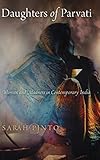Daughters of Parvati : Women and Madness in Contemporary India / Sarah Pinto.
Material type: TextSeries: Contemporary EthnographyPublisher: Philadelphia : University of Pennsylvania Press, [2014]Copyright date: ©2014Description: 1 online resource (296 p.) : 2 illusContent type:
TextSeries: Contemporary EthnographyPublisher: Philadelphia : University of Pennsylvania Press, [2014]Copyright date: ©2014Description: 1 online resource (296 p.) : 2 illusContent type: - 9780812245837
- 9780812209280
- Mentally ill women -- Care -- India
- Psychiatric hospitals -- India
- Psychiatry -- India -- History -- 21st century
- Women -- Mental health services -- India
- Middle Eastern
- SOCIAL SCIENCE / Anthropology / General
- African Studies
- Anthropology
- Asian Studies
- Folklore
- Gender Studies
- Linguistics
- Middle Eastern Studies
- Women's Studies
- 362.2/20954 23
- RC451.I4 .P56 2014eb
- online - DeGruyter
- Issued also in print.
| Item type | Current library | Call number | URL | Status | Notes | Barcode | |
|---|---|---|---|---|---|---|---|
 eBook
eBook
|
Biblioteca "Angelicum" Pont. Univ. S.Tommaso d'Aquino Nuvola online | online - DeGruyter (Browse shelf(Opens below)) | Online access | Not for loan (Accesso limitato) | Accesso per gli utenti autorizzati / Access for authorized users | (dgr)9780812209280 |
Browsing Biblioteca "Angelicum" Pont. Univ. S.Tommaso d'Aquino shelves, Shelving location: Nuvola online Close shelf browser (Hides shelf browser)

|

|

|

|

|

|

|
||
| online - DeGruyter Taming Lust : Crimes Against Nature in the Early Republic / | online - DeGruyter The Organization Man / | online - DeGruyter Electing the President, 2012 : The Insiders' View / | online - DeGruyter Daughters of Parvati : Women and Madness in Contemporary India / | online - DeGruyter The Life of Benjamin Franklin. Volume 2, The Life of Benjamin Franklin, Volume 2 ; Printer and Publisher, 173-1747 / | online - DeGruyter Convention Center Follies : Politics, Power, and Public Investment in American Cities / | online - DeGruyter Histories of Victimhood / |
Frontmatter -- Contents -- Note on Transliterations -- Introduction: Love and Affliction -- 1. Rehabilitating Ammi -- 2. On Dissolution -- 3. Moksha and Mishappenings -- 4. On Dissociation -- 5. Making a Case -- 6. Ethics of Dissolution -- Bibliography -- Index -- Acknowledgments
restricted access online access with authorization star
http://purl.org/coar/access_right/c_16ec
In her role as devoted wife, the Hindu goddess Parvati is the divine embodiment of viraha, the agony of separation from one's beloved, a form of love that is also intense suffering. These contradictory emotions reflect the overlapping dissolutions of love, family, and mental health explored by Sarah Pinto in this visceral ethnography.Daughters of Parvati centers on the lives of women in different settings of psychiatric care in northern India, particularly the contrasting environments of a private mental health clinic and a wing of a government hospital. Through an anthropological consideration of modern medicine in a nonwestern setting, Pinto challenges the dominant framework for addressing crises such as long-term involuntary commitment, poor treatment in homes, scarcity of licensed practitioners, heavy use of pharmaceuticals, and the ways psychiatry may reproduce constraining social conditions. Inflected by the author's own experience of separation and single motherhood during her fieldwork, Daughters of Parvati urges us to think about the ways women bear the consequences of the vulnerabilities of love and family in their minds, bodies, and social worlds.
Issued also in print.
Mode of access: Internet via World Wide Web.
In English.
Description based on online resource; title from PDF title page (publisher's Web site, viewed 30. Aug 2021)


